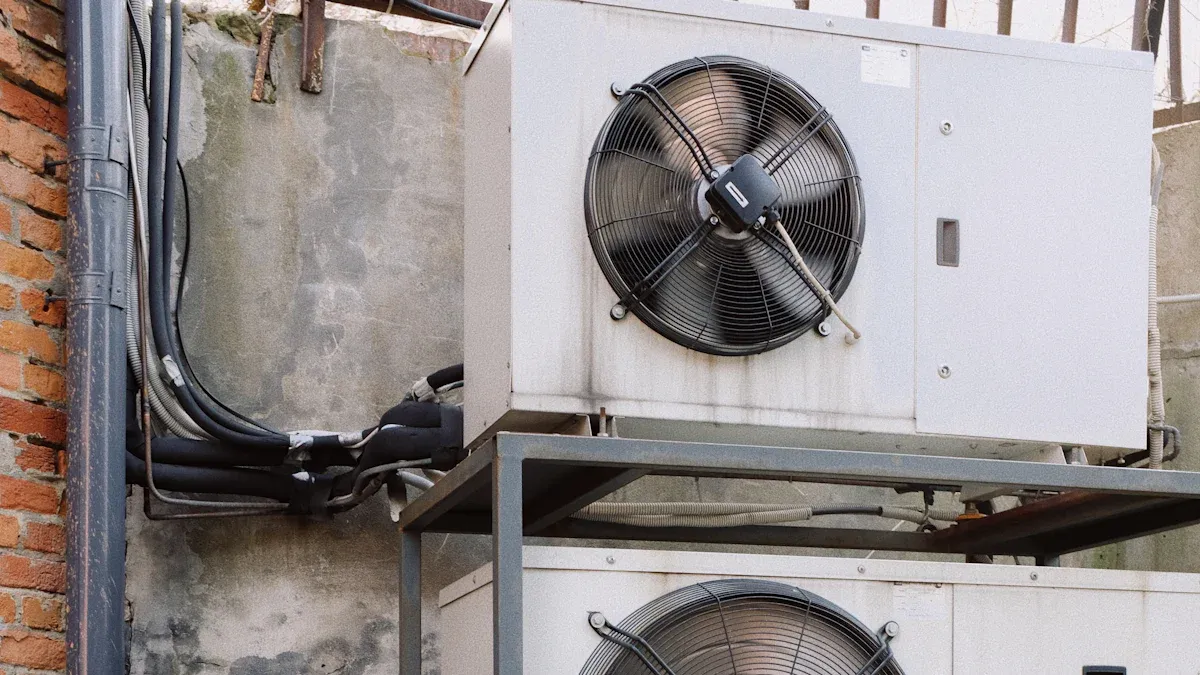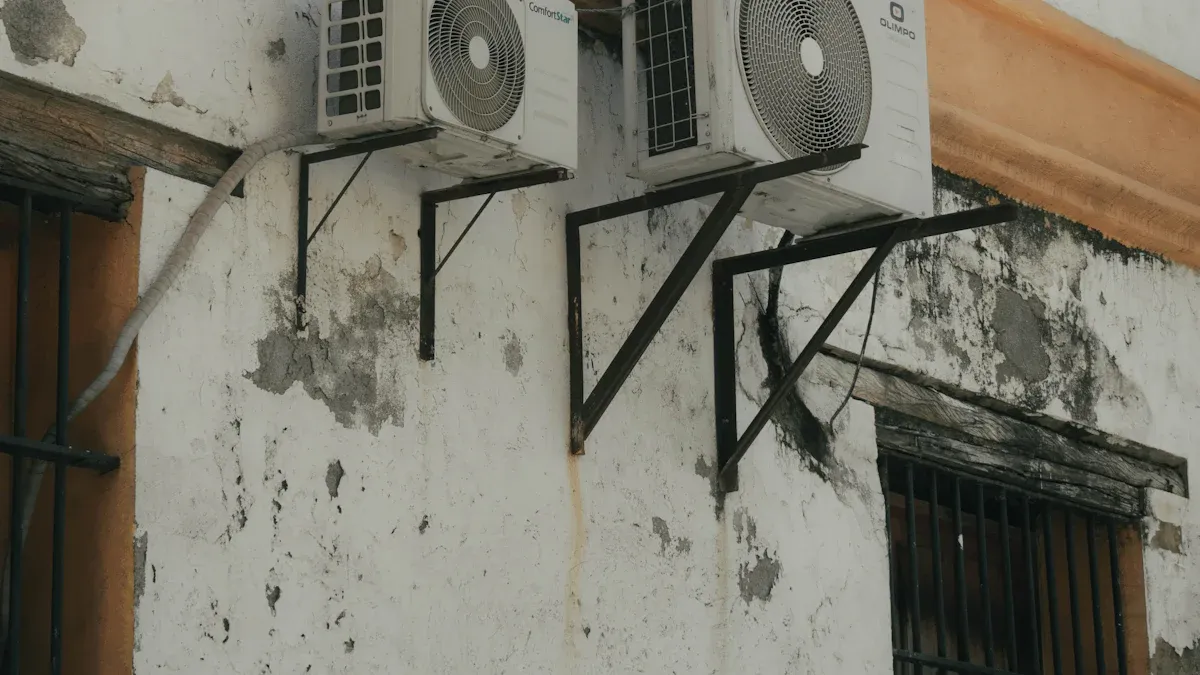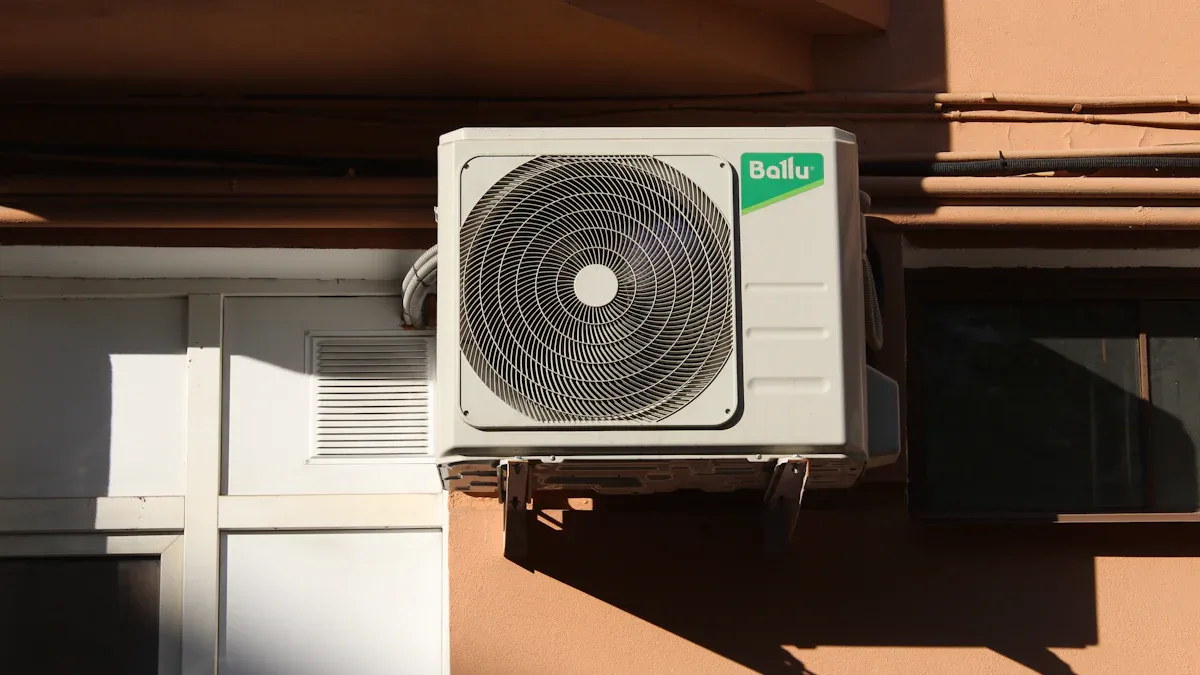Copper vs. Aluminum Condensers: Lifecycle Cost Analysis

When I evaluate condenser materials, lifecycle cost stands out as a critical factor. Copper condensers often outperform aluminum in strength and reliability, as Bob Forty highlights. Aluminum’s maintenance challenges and repair complexity can significantly increase long-term costs. Yet, regulatory trends, like the EU’s CBAM, are driving a shift toward aluminum. Wire Tube Condenser designs also play a role in optimizing lifecycle costs.
Key Takeaways
- Copper condensers cost more at first but last longer. They need less fixing, saving money over time.
- Aluminum condensers are cheaper to buy but break faster. Fixing and replacing them costs more later.
- Picking the right condenser affects energy use and costs. Copper cools better and lowers energy bills.
Initial Costs
Cost of Copper Condensers
When I evaluate copper condensers, their upfront cost often reflects the premium quality of the material. Copper’s high thermal conductivity and durability make it a preferred choice for many applications, but these advantages come at a price. On average, copper condensers tend to cost more than their aluminum counterparts due to the material’s scarcity and higher production expenses. For industries requiring robust and long-lasting solutions, this initial investment often proves worthwhile.
Tip: Copper’s higher initial cost can be offset by its longer lifespan and lower maintenance needs, making it a strategic choice for applications demanding reliability.
Cost of Aluminum Condensers
Aluminum condensers offer a more budget-friendly option for those seeking cost-effective solutions. The material’s lightweight nature and ease of manufacturing contribute to its lower price point. I’ve noticed that aluminum condensers are particularly popular in industries where cost control is a priority. However, the reduced upfront cost may come with trade-offs in terms of durability and repair complexity.
| Material | Average Initial Cost | Key Advantage |
|---|---|---|
| Copper | Higher | Durability and reliability |
| Aluminum | Lower | Lightweight and affordable |
Factors Influencing Initial Costs
Several factors influence the initial costs of condensers. Material availability plays a significant role, with copper being less abundant than aluminum. Manufacturing processes also impact pricing; copper requires more intricate handling due to its density and malleability. Additionally, the intended application determines the choice of material, as industries with specific performance requirements may prioritize copper despite its higher cost.
By understanding these factors, I can make informed decisions that align with both budget constraints and long-term operational goals.
Durability and Longevity

Corrosion Resistance of Copper vs. Aluminum
When I assess the corrosion resistance of copper and aluminum, copper consistently stands out. Copper’s natural ability to resist corrosion makes it ideal for environments with high humidity or exposure to water. It forms a protective patina over time, which shields the material from further degradation. Aluminum, on the other hand, relies on its oxide layer for protection. While this layer offers some resistance, it can break down in highly corrosive conditions, such as exposure to saltwater or industrial pollutants.
Note: Copper’s superior corrosion resistance often translates into fewer repairs and replacements, making it a cost-effective choice for long-term applications.
Wear and Tear Over Time
The wear and tear of condensers depend heavily on the material’s mechanical properties. Copper’s malleability and tensile strength allow it to withstand physical stress and repeated use without significant damage. I’ve observed that copper condensers maintain their structural integrity even under demanding conditions. Aluminum, while lightweight and easier to handle, is more prone to dents and deformation. Over time, this susceptibility to physical damage can lead to performance issues.
| Material | Resistance to Wear and Tear | Key Strength |
|---|---|---|
| Copper | High | Strong and malleable |
| Aluminum | Moderate | Lightweight |
Expected Lifespan of Each Material
The expected lifespan of a condenser is a critical factor in lifecycle cost analysis. Copper condensers typically last longer due to their durability and resistance to environmental factors. In my experience, copper units can operate efficiently for 15–20 years with proper maintenance. Aluminum condensers, while more affordable initially, often have a shorter lifespan, averaging 10–15 years. This difference in longevity can significantly impact replacement costs over time.
Tip: Investing in copper condensers may reduce long-term expenses by minimizing the frequency of replacements.
Maintenance Requirements and Costs
Maintenance Needs for Copper Condensers
Copper condensers require consistent upkeep to maintain their efficiency and extend their lifespan. I prioritize regular inspections to identify corrosion, leaks, or any malfunctioning components. Cleaning the evaporator coils and blades is essential to prevent dirt buildup, which can hinder performance. Operational checks, such as verifying pressure readings and ensuring safety controls are functional, help avoid unexpected failures. Oil analysis is another critical step. Testing oil samples for contaminants and replacing them when necessary ensures smooth operation. Maintenance intervals vary based on equipment type, but I recommend scheduling checks every three, six, or twelve months.
Tip: Proactive maintenance for copper condensers reduces the risk of costly repairs and ensures optimal performance over time.
Maintenance Needs for Aluminum Condensers
Aluminum condensers demand a different approach due to their material properties. Cleaning is crucial since dirt and debris can compromise their efficiency faster than copper. Inspections should focus on the integrity of the oxide layer, which protects against corrosion. I find that aluminum’s susceptibility to physical damage requires more frequent checks for dents or deformation. While aluminum condensers are lighter and easier to handle, their maintenance needs can become more frequent, especially in harsh environments.
Long-Term Maintenance Cost Comparison
When comparing long-term maintenance costs, copper condensers often prove more economical despite their higher initial investment. Their durability and efficiency reduce the frequency of repairs and replacements. Aluminum condensers, while cheaper upfront, may incur higher running costs due to their shorter lifespan and increased maintenance needs.
| Coil Material | Cost | Durability | Efficiency |
|---|---|---|---|
| Aluminum | Lower | Less durable | Less efficient |
| Copper | Higher | More durable | More efficient |
Note: Choosing copper condensers can lead to significant savings in maintenance expenses over the lifecycle of the equipment.
Energy Efficiency and Performance

Heat Transfer Efficiency of Copper vs. Aluminum
When I compare the heat transfer efficiency of copper and aluminum, copper consistently outperforms aluminum. Copper’s thermal conductivity measures 384.0 W/mK, significantly higher than aluminum’s 138.5 W/mK. This difference allows copper to transfer heat more effectively, making it ideal for applications requiring high thermal performance.
| Feature | Copper Advantages | Aluminum Disadvantages |
|---|---|---|
| Heat Transfer Efficiency | Higher heat transfer rates due to microgroove technology | Lower efficiency due to flat tube designs |
| Durability | More durable and corrosion-resistant | Prone to corrosion, requiring coatings |
| Manufacturing Technology | Advanced technologies for smaller diameter tubes | Limited options for efficient manufacturing |
| Moisture Removal | Better moisture drainage from evaporator coils | Less effective moisture removal |
Innovations in aluminum manufacturing have improved its performance, but copper remains the superior choice for heat transfer efficiency.
Impact on Energy Consumption
The material used in a condenser directly affects energy consumption. Copper’s higher thermal conductivity reduces the time and energy required for heat exchange. This efficiency translates into lower operational costs over the equipment’s lifecycle. Aluminum, while lighter and easier to handle, often requires more energy to achieve the same cooling performance.
- Key Metrics:
- Copper condensers achieve higher energy efficiency due to their superior heat transfer properties.
- Aluminum condensers, despite being cost-effective, may lead to higher energy bills over time.
By choosing copper condensers, I can optimize energy usage and reduce long-term expenses.
Performance in Different Environmental Conditions
Environmental conditions play a crucial role in condenser performance. Copper condensers excel in both standard and harsh environments due to their durability and corrosion resistance. For instance:
| Condenser Type | Thermal Efficiency Description | Corrosion Resistance Description | Recommended Environment |
|---|---|---|---|
| Standard Coil Construction | High thermal efficiency through direct metallic contact; maximum thermal performance achieved. | Highest performance for non-corrosive environments; not recommended for marine or industrial use. | Non-corrosive environments only. |
| Copper-Fin Coils | Increased corrosion resistance in harsh coastal environments. | Eliminates bi-metallic bond; suitable for coastal areas without industrial pollution. | Harsh coastal environments. |
| Postcoated Aluminum-Fin Coils | Tough baked-on organic coating prevents contamination. | Protects against harsh coastal conditions and industrial contamination. | Harsh coastal and industrial environments. |
Copper’s versatility makes it a reliable choice across diverse climates, ensuring consistent performance and reduced maintenance needs.
Tip: For environments with high humidity or industrial pollutants, copper condensers provide unmatched reliability and efficiency.
Total Lifecycle Costs
Repair Costs for Copper and Aluminum Condensers
When I evaluate repair costs, copper condensers often prove more economical in the long run. Copper’s durability and resistance to wear reduce the frequency of repairs. For instance, copper’s malleability allows for easier repairs when leaks or damages occur. Technicians can often fix copper components without replacing entire sections, which minimizes downtime and costs.
Aluminum condensers, on the other hand, present unique challenges. Their susceptibility to physical damage, such as dents or cracks, often requires more extensive repairs. Aluminum’s lower tensile strength makes it harder to repair without specialized tools or techniques. In some cases, damaged aluminum parts may need complete replacement, which increases repair expenses.
Note: Copper’s repair-friendly nature can significantly lower maintenance costs over the condenser’s lifecycle, especially in demanding applications.
Replacement Costs Over Time
Replacement costs play a crucial role in lifecycle cost analysis. Copper condensers, with their longer lifespan, require fewer replacements. In my experience, a well-maintained copper condenser can last 15–20 years. This longevity reduces the frequency of replacements, which translates into substantial savings over time.
Aluminum condensers, while cheaper initially, often need replacement after 10–15 years. Their shorter lifespan results from their lower resistance to corrosion and physical wear. Frequent replacements not only increase costs but also disrupt operations, which can impact productivity.
| Material | Average Lifespan | Replacement Frequency | Impact on Costs |
|---|---|---|---|
| Copper | 15–20 years | Less frequent | Lower long-term costs |
| Aluminum | 10–15 years | More frequent | Higher long-term costs |
Tip: Investing in copper condensers may seem costly upfront, but their extended lifespan makes them a cost-effective choice for long-term use.
Overall Cost Comparison
When I compare the total lifecycle costs of copper and aluminum condensers, copper emerges as the more cost-effective option. Its higher initial cost is offset by lower repair and replacement expenses. Copper’s superior durability and efficiency contribute to reduced operational and maintenance costs, making it a reliable choice for industries prioritizing long-term savings.
Aluminum condensers, while appealing due to their lower upfront cost, often incur higher expenses over time. Frequent repairs, shorter lifespans, and increased energy consumption add to their total cost. For applications where budget constraints are critical, aluminum may serve as a viable option. However, for those seeking durability and efficiency, copper remains unmatched.
| Cost Factor | Copper Condensers | Aluminum Condensers |
|---|---|---|
| Initial Cost | Higher | Lower |
| Repair Costs | Lower | Higher |
| Replacement Costs | Less frequent, lower costs | More frequent, higher costs |
| Energy Efficiency | Higher, lower energy bills | Lower, higher energy bills |
| Total Lifecycle Cost | More cost-effective overall | Higher over time |
Conclusion: Copper condensers offer a better balance of durability, efficiency, and cost-effectiveness over their lifecycle. For industries aiming to optimize long-term operational costs, copper is the superior choice.
Wire Tube Condenser Applications
Role of Wire Tube Condensers in Refrigeration
Wire tube condensers play a pivotal role in refrigeration systems by enhancing performance and efficiency. These condensers are designed to optimize heat dissipation, which directly impacts the cooling process.
- The high-pressure refrigerant gas enters the coiled tubing, where heat is rapidly transferred to the tube walls due to copper’s excellent thermal conductivity.
- The wire tube design increases the effective heat dissipation surface area while maintaining structural stability.
- Ambient air flows over the tubes, cooling the refrigerant until it condenses into a liquid.
Switching to advanced designs, such as mini-channel flat tube condensers, can further reduce refrigerant charge and improve energy efficiency. This innovation lowers energy consumption and operational costs, positively influencing lifecycle cost analysis. However, the performance of refrigeration systems is often evaluated as a whole, which can obscure the specific benefits of wire tube condensers.
| Function of Wire Tube Condensers in Refrigeration |
|---|
| Rapidly transfers heat from refrigerant to tube walls |
| Enhances structural stability and heat dissipation |
| Cools refrigerant until it condenses into a liquid |
Senjun’s Expertise in Wire Tube Condensers
At Senjun, I’ve seen how expertise in wire tube condensers drives innovation. The company specializes in developing high-quality condensers for various applications, including refrigerators, freezers, and medical ultra-low temperature refrigerators. Senjun’s focus on research and development ensures that their products meet the highest standards of efficiency and durability. By leveraging advanced manufacturing techniques, Senjun delivers condensers that excel in both performance and cost-effectiveness.
Benefits of Wire Tube Condensers in Lifecycle Cost Analysis
Wire tube condensers offer several advantages when analyzing lifecycle costs. Their efficient heat transfer reduces energy consumption, leading to lower operational expenses. The durable design minimizes maintenance needs and extends the lifespan of refrigeration systems. Additionally, the reduced refrigerant charge in advanced designs contributes to environmental sustainability and cost savings. These factors make wire tube condensers a smart choice for industries aiming to optimize long-term costs.
Tip: Choosing a reliable manufacturer like Senjun ensures that you benefit from the full potential of wire tube condensers in your refrigeration systems.
After analyzing copper and aluminum condensers, I find copper excels in durability, efficiency, and long-term cost savings. Aluminum offers lower initial costs but higher maintenance and replacement expenses.
Recommendation: Choose copper for reliability and performance.
Senjun’s advanced wire tube condensers and copper-aluminum fin heat exchangers deliver unmatched quality, ensuring optimal lifecycle value.
FAQ
What are the main advantages of copper condensers over aluminum?
Copper condensers excel in durability, corrosion resistance, and heat transfer efficiency. These qualities reduce maintenance needs and energy consumption, making them a cost-effective choice for long-term use.
How does Senjun ensure the quality of its wire tube condensers?
Senjun uses advanced manufacturing techniques and rigorous quality control. Their focus on research and development ensures high-performance condensers tailored to diverse refrigeration applications.
Are wire tube condensers suitable for harsh environments?
Yes, wire tube condensers perform well in harsh conditions. Their durable design and efficient heat dissipation make them reliable for environments with high humidity or industrial pollutants.


















